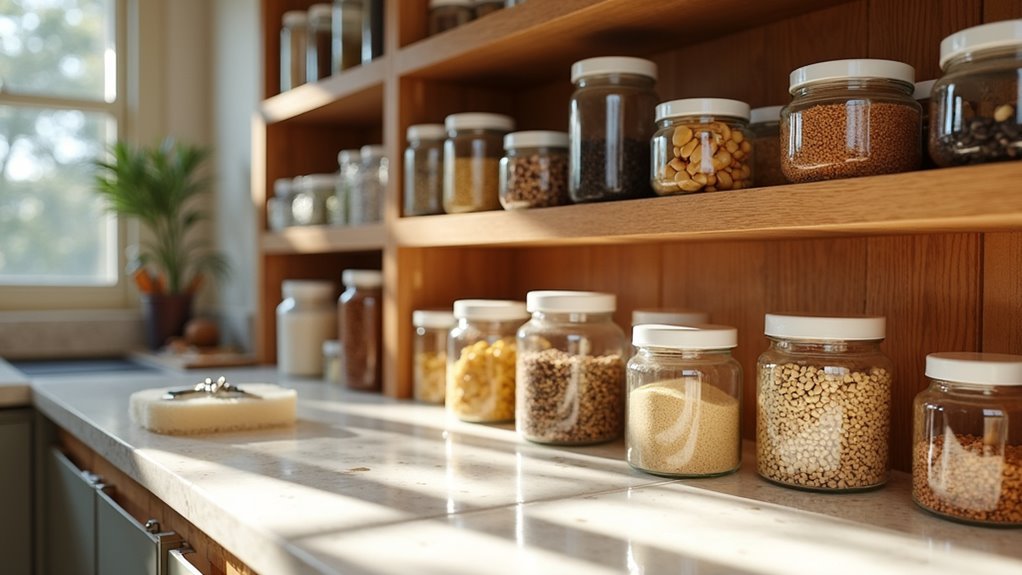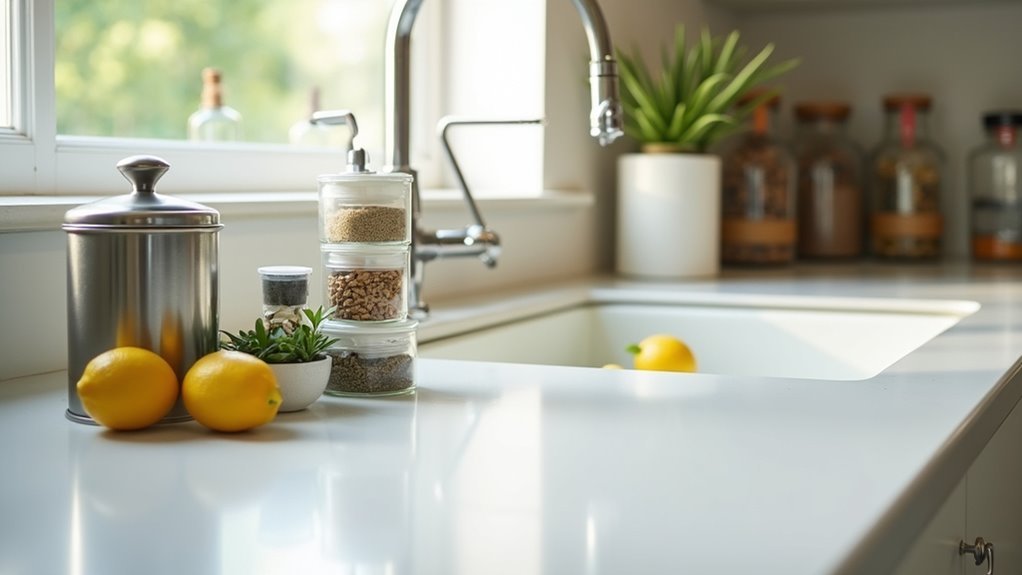You’ll prevent most kitchen pest problems by focusing on three critical monthly tasks. First, deep clean all food storage areas by removing items, disinfecting surfaces, and transferring non-perishables into airtight containers. Second, seal cracks and entry points using silicone caulk around plumbing lines and install door sweeps on exterior doors. Third, eliminate moisture sources by checking for leaks around appliances and repairing them immediately. These proactive measures create an inhospitable environment that keeps pests away from your kitchen year-round.
Deep Clean and Inspect All Food Storage Areas

When you’re serious about keeping pests out of your kitchen, start with an extensive monthly inspection of all food storage areas.
Look carefully for pest droppings, damaged packaging, or other warning signs in your pantry and cabinets. Remove everything from shelves and deep clean all surfaces with disinfectant. Vacuum corners thoroughly to eliminate crumbs and pest attractants that might draw unwanted visitors.
Deep clean all pantry surfaces with disinfectant and vacuum corners thoroughly to eliminate crumbs that attract unwanted pests.
Check expiration dates on all products and toss expired items immediately, as they’re magnets for pantry moths and beetles.
Transfer remaining non-perishables into airtight containers to block pest access. Address any spills inside cabinets right away, and wipe down containers before returning them to storage.
This monthly routine creates an inhospitable environment for pests.
Seal Cracks and Entry Points Throughout the Kitchen
Clean storage areas won’t protect your kitchen if pests can still slip through cracks and gaps around your home’s perimeter.
You’ll need to inspect and seal entry points throughout your kitchen to prevent pests from infiltrating your space. Use silicone-based caulk or expandable foam to seal cracks around plumbing, electrical lines, and baseboards where insects might gain access.
| Entry Point | Sealing Method |
|---|---|
| Windows/doors | Caulk gaps and cracks |
| Plumbing lines | Expandable foam |
| Electrical outlets | Silicone caulk |
| Door thresholds | Install door sweeps |
Don’t forget essential repairs like damaged window screens that allow insects inside. Install door sweeps on exterior doors to block crawling pests like mice. Conduct seasonal inspections of your kitchen’s foundation and exterior walls—seasonal shifts often reveal new vulnerabilities requiring immediate attention for effective pest prevention.
Check and Eliminate Moisture Sources Around Appliances

Even after sealing entry points, pests will still find their way into your kitchen if you’re providing them with their most essential need: water.
Check for leaks around dishwashers, ice makers, and sink connections monthly, repairing them immediately to prevent future infestations.
Monthly leak inspections around appliances and immediate repairs are your first line of defense against kitchen pest invasions.
Clean appliances thoroughly, removing accumulated moisture and food debris from behind and beneath refrigerators and dishwashers.
Monitor humidity levels and use dehumidifiers when necessary to eliminate moisture that attracts pests.
Wipe down all appliance surfaces, including tops and sides, after cooking activities.
Seal gaps around appliances with silicone caulk to block moisture escape routes.
These essential kitchen pest prevention and pest control tips will greatly reduce the water sources that draw unwanted visitors into your cooking space.
Frequently Asked Questions
How to Prevent Pest Infestation in Kitchen?
You’ll prevent kitchen pest infestations by cleaning surfaces daily, storing food in airtight containers, disposing trash in sealed bins, fixing leaks promptly, and sealing cracks around windows, doors, and pipes.
Is Monthly Pest Control Worth It?
Monthly pest control’s absolutely worth it if you’re dealing with recurring infestations or live in high-risk areas. You’ll save money long-term by preventing major problems, plus you’ll get professional-grade treatments that work better than DIY solutions.
Which Method of Pest Prevention Is Most Effective?
You’ll find sealing food in airtight containers is most effective for pest prevention. It eliminates food sources that attract ants, roaches, and rodents, cutting off their primary reason for entering your kitchen space.
Which Practice Is Most Effective in Controlling Pests in the Kitchen?
You’ll find that regularly cleaning kitchen surfaces is most effective for controlling pests. It eliminates up to 90% of food particles and spills that attract ants and cockroaches to your kitchen.
In Summary
You’ll keep your kitchen pest-free by staying consistent with these three monthly actions. Don’t skip the deep cleaning and inspection of food storage areas, as even small crumbs attract unwanted visitors. Remember to seal those tiny cracks you might’ve missed before, and always check for moisture buildup around your appliances. Make these tasks part of your regular routine, and you’ll prevent pest problems before they start.





Leave a Reply